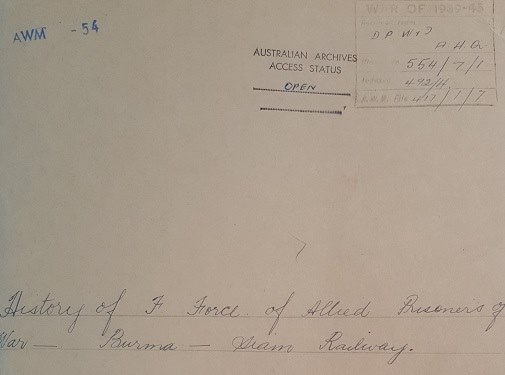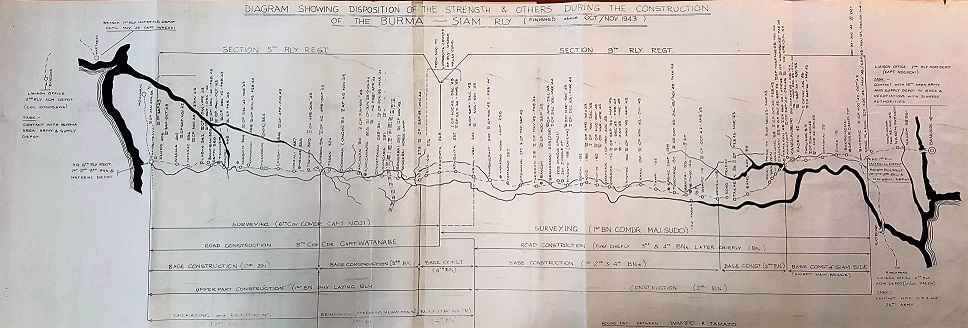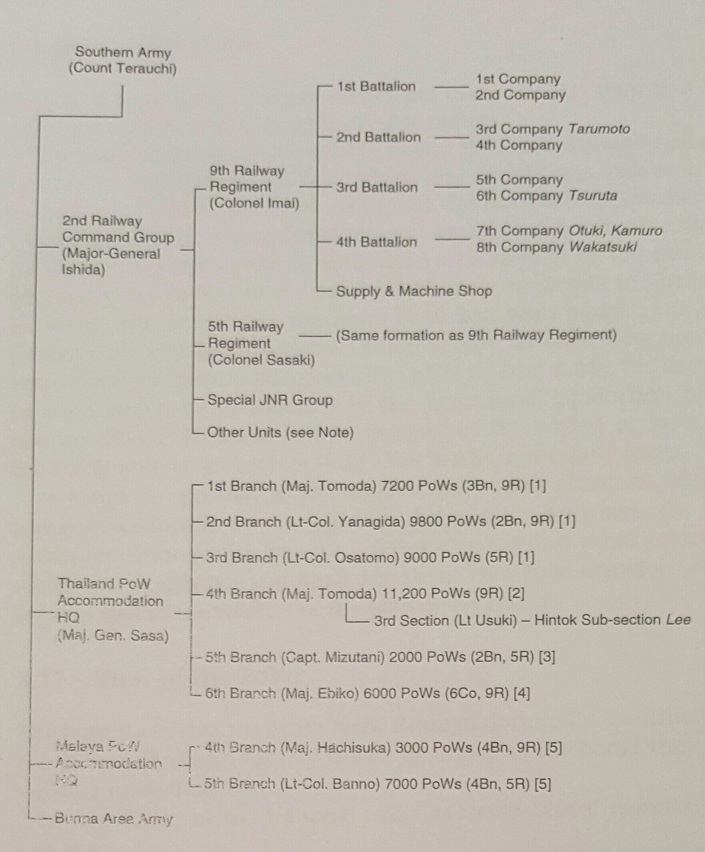

Cover of file 554/7/1.
By Andrew Warland
From January 1942, Japanese military forces with the support of the newly formed Burma Independence Army invaded Burma seeking, among other objectives, to cut off the supply route for Chinese nationalists along the so-called Burma Road that connected India and China via Burma. The Japanese military’s own supply route via the Andaman Sea was, however, increasingly disrupted by allied attacks on Japanese ships. The Japanese needed a more secure supply route.
The fall of Malaya, Singapore and the Dutch East Indies (now Indonesia) in February and March 1942, meant that the Japanese had at their disposal tens of thousands of British, Commonwealth, Dutch and American prisoners of war. Accordingly, it was decided to use these men, along with local labour, to construct a railway line between Thanbyuzayat, Burma and Nong Pladuk/Ban Pong, Thailand.
The construction of a railway line to provide a land-based supply line between Thailand and Burma was a key part of Japanese strategic military planning. The Japanese Southern Area Army Field Railway Headquarters was under the direct command of the Japanese Supreme Commander for South East Asia. The Thai-Burma railway line was the responsibility of the 5th and 9th Railway Regiments of the 2nd Railway Brigade, both with around 2,300 men.
The 5th Railway Regiment was established in April 1938 and saw action and constructed or repaired railways in China, Burma, Malaya and Singapore. The 9th Railway Regiment was formed in September 1941 and saw action in Indochina and Burma before transferring to Bangkok.
After considering five potential routes, the Japanese Imperial Command Group issued the first order for the construction of a railway from Kanchanaburi in Thailand to Thanbyuzayat in Burma on 12 March 1942. The proposed route was surveyed (on the back of elephants) and detailed construction plans were prepared. In May 1942, a single Battalion from each of the 9th and 5th Railway Regiments were sent to Banpong and Thanbyuzayat respectively to commence survey work. Formal instructions for the construction of the railway were issued in June 1942; construction was expected to be completed by May 1943. 50,000 POWs and local labour, called 'romushu' by the Japanese and 'coolies' by the non-local population, were to be engaged for the construction.
An additional part of the Japanese Southern Area Army Field Railway Headquarters was the 4th Special Railway Headquarters. This group was organised to take over the management of the railway line after it was completed. It included a number of para-military (gunzoku) units, some of which assisted in the construction work.
The first group of around 3,000 prisoners of war, known as A Force and commanded by Brigadier A A Varley, arrived in Burma from Singapore in May 1942 and were initially assigned to the construction of airfields. The groups then came together again and moved to Thanbyuzayat, south of Moulamein (Mawlamyine), in Burma.
In June 1942, the 5th Railway Regiment under Lt Col Sasaki Manosahe (from August 1942 to May 1945), less one battalion still in China, travelled to Thanbyuzayat to commence work on the northern end of the railway. It was also involved in repairs and re-construction of parts of the line north of Thanbyuzayat. The remaining battalion arrived in March 1943 and travelled south to work on the line between Nieke and Tamuron Pat. The 9th Regiment commenced work from Nong Pladuk in July 1942, with construction of bridges starting at several points along the line. By January 1943, construction work had reached Takanun. Between March and May 1943, the Regiment also worked on the construction of bridges in the Kinsaiyok area.
Several thousand more prisoners of war, including Australians, Dutch and Americans from Java , arrived in the Thanbyuzayat area in October 1942 and January 1943 to work on the northern end of the railway line. At the southern end of the line, Dunlop Force, consisting mostly of prisoners captured in Java and commanded by Colonel E E 'Weary' Dunlop, arrived at Ban Pong/Nong Pladuk, Thailand in January 1943 and then gradually moved north. Dunlop Force was joined by D Force in March 1943.

Diagram showing disposition of the strength and others during the constructions of the Burma-Siam Railway (from file 554/7/8).
Although a December 1943 deadline for completion of the railway had been agreed after the original May deadline was amended, the completion date for the railway was changed by Tokyo Headquarters in early 1943 to August of the same year. In order to complete the work on time, the 5th Railway Regiment’s 4th Battalion was transferred from China to Burma and an additional 10,000 POWs were sought to work on the line; these POWs were to became F and H Forces.
In addition to the 5th and 9th regiments already in place, the more mobile 4th Engineer Regiment of the Imperial Guards Engineering Corps, commanded by Colonel Asami Makato, was transferred to the line with responsibility for the road and railway from Tamuron Pat to Nieke. One of the members of that Regiment was Maruyama Hajime, who parts of F Force were to have the misfortune to encounter, as we shall see. A range of other units were transferred to the railway including the 21st Division Field Hospital, a motor transport company with 700 trucks and part of the Japanese Epidemic Prevention and Water Supply Depot. Additionally, several gonzoku units were attached to the 5th and 9th Railway Regiments for short periods, including in the areas where F Force was located.

Structure of Japanese forces on the Thai-Burma Railway. (Source: Tamayama, 2005)
The Japanese sought an additional 7,000 men in April 1943, luring them on the proposition that those who volunteered would experience much better living and working conditions further north. The new force was to be named F Force. Of the 7,000 men, 3,662 were Australians. Many men were members of either the Australian 8th Division's 2/29th (Lt Col Pond) and 2/30th Battalions. The men travelled on 13 separate trains to Ban Pong from 16 to 26 April 1943, arriving several days later, only to find that they were required to march a further 300 kilometres north to reach their working camps.
Location of F Force elements during 1943.
POWs in the Malaya area were the responsibility of the Japanese POW Administration, under the command of Major General Arimura (from December 1942). POWs were divided by that Administration into Groups and Branches, the latter 'under a Japanese commander who was responsible for all matters of accommodation, supply, administration and camp control'. Each Branch of POWs was also assigned a letter; the 4th Branch of POWs, under Lt Col Banno Hirateru, was designated ‘F’ Force.
North of Tamuron Pat in Thailand, the 4th Branch - but not its POWs, who remained under the control of the Malaya POW Administration - came under the command of the 5th Railway Regiment. To further add to this command and control confusion, the 42nd Commissariat Unit was responsible for food and accommodation on the March from Banpong north. Sanitation was the responsibility of the medical unit of the Southern Railway Command. This multiplicity of responsibilities was a frequent cause of hardships (marches and manual carrying instead of using trucks or the river) and deprivations (food and medicine) for POWs and the local labour force along the line. Post-war trials frequently note the negligence of Japanese and Koreans responsible for POWs caused, at least in part, by these multiple lines of responsibility.

Cover of file 554/7/1.
The official Australian history of F Force is recorded in at least ten files, eight with the 554/7/n numbering pattern, in series AWM54 held by the Australian War Memorial (AWM). Six of the 554/7/n files, three of which have two parts, contain around 130 documents (some duplicated between files, some with different versions or drafts, some with multiple documents contained in the main document), tables, and hand-drawn maps. One file (554/7/7, an album of plastic sleeves) contains a further 120 or so document 'scraps' relating to preparations for the departure of F Force for Thailand. One file (554/7/6) has been missing since 2005.
Two other files, 554/11/4, parts 2 and 13 with the following words in the title 'Appendices to the History of "F" Force', contain copies of documents in the 554/7/n set. Apart from two single-page covering letters in 554/11/4 Part 2 (which look to be missing from the other files), they do not contain any different documents.
All of the documents in the 554/7/n set were transcribed from the original paper files from late 2015 to early 2016.
An index, and then each of the files in the series is described below. PLEASE CONTACT ME IF YOU WISH TO ACCESS THESE DOCUMENTS (email at bottom of page).
British Official History. An identical copy of the 'F Force' Official Report by Col Harris, contained in files 554/7/1, 554/7/2 and 554/7/4, is held in The National Archives of the UK (references PRO WO 325/18 and WO 325/16). The British copy, as well as most of the associated correspondence documents, have been reproduced in Kratoska, Paul H. ‘The Thailand-Burma Railway,1942-1946: Documents and Selected Writings’. Routledge, United Kingdom, 2006.
War Crimes versions. Two exact copies of Lt Col Kappe’s report (including the seven appendices) contained in file 554/7/4, and titled ‘"F" Force Report by Lt Col Kappe 5.5.44’, were re-typed from the original in the mid 1940s with minor typographical corrections. These documents formed part of a collection of 24 items supporting the post-war Australian War Crimes Commission. A digitised copy of both documents may be viewed online at the National Archives of Australia website www.naa.gov.au (Series number A6238, Control symbol 23, item barcode 3073884, alternative series and control symbol: A4311, 735/7).
Cumpston Collection. Another copy of Lt Col Kappe’s report, exactly the same as the War Crimes Commission report, was included in the extensive ‘Cumpston Collection’ of documents relating to the history of Australian foreign policy. The copy of the report was contained in a file titled ‘Australian War Crimes Commission. Report of activities of AIF, component F Force (Japanese War Crimes)’. The top cover of the file states in handwriting that it is ‘identical with A4311 TT 735/7 (23) in A6238’. A digitised copy of this document may be viewed online at the National Archives of Australia website (Series number A4311, Control symbol 658/4, item barcode 3175356, alternative series and control symbol: A4311, 658/4).
The Department of Defence owns the content and copyright of both the original file and the transcribed version. The Australian War Memorial, as the custodian and on behalf of the Army History Unit, extended its permission to Andrew Warland to create and provide access to the PDF format of these files for non-commercial purposes, provided certain conditions were met:
Australian Army History Unit
CP2-5-163, PO Box 7911
Department of Defence
CANBERRA BC ACT 2610
Andrew Warland is a Melbourne-based Information Management specialist and the grandson of Lt Col John Charles Robertson, Commanding Officer of the 2/29th Battalion until his death on 18 January 1942 at Bakri in action against Japanese forces. His troops fought on but eventually were forced to withdraw under fire. The remnants of the Battalion joined up with the 2/19th Battalion and returned to Singapore, losing many men in the process. Many of the survivors, along with reinforcements who joined in Singapore, under the command of Lt Col S.A.H. Pond, ended up working on the Thai Burma Railway as part of the 7,000 strong combined UK/Australian group known as 'F Force'.
Added 7 January 2020, updated 9 April 2020. Copyright © Andrew Warland. (andrewwarland(at)gmail.com)